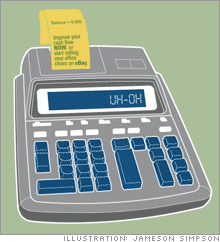|
Bolt down those costs
How artificial intelligence keeps a truck business on track.
(FORTUNE Small Business) - Ron Towry thought he knew his way around a balance sheet. The owner of Truck Gear SuperCenter, a Houston-based truck-accessory retailer, Towry, 62, once served as CEO of Leer, a $400-million-a-year manufacturer of truck accessories. "I'm very seasoned at managing a business," he says.
And he appeared to be doing a good job at Truck Gear since he started the company in 2001. Revenue rose 25% to $2.5 million in 2004, while profits climbed 32%. When he learned about ProfitCents, a web-based accounting software program, he tried it mainly out of curiosity. "I really thought I was in good shape," he says. But ProfitCents - which automatically interprets balance-sheet data and prints out an analysis in easy-to-read English - told a different story. It zeroed in on a problem Towry didn't know he had: cash flow. Not long before using the software, Towry had made a strategic shift in his business, expanding beyond retail customers and selling more products wholesale at lower profit margins to truck and auto dealerships. While the move had boosted annual sales by $450,000, it had also extended the firm's receivables - to as many as 50 days from five or ten. ProfitCents saw trouble, and urged Towry to "consider lengthening the amount of time in which you pay your suppliers, and shortening the amount of time in which your customers pay you." The advice, Towry says, helped save his business: "Even though my P&L looked good, I didn't realize I was headed to a point where I had no cash to operate." Towry is the kind of client Sageworks, the Raleigh software firm that created ProfitCents, hopes to target. "Most small-business owners are smart, college-educated, and have great savvy in operations and sales, but they really can't make heads or tails of their financial statements," says Brian Hamilton, CEO of Sageworks, which charges a variable annual fee for access to the ProfitCents site (profitcents.com). "This is like an automated CFO for small businesses." A former CFO himself, Hamilton founded Sageworks in 1998 with Sarah Tourville, an information technology consultant with whom he created a patented technology called FIND. It aggregates data from a firm's general ledger and compares its performance to that of similar companies in its industry. Then, using artificial-intelligence software that Hamilton developed, it translates those findings into narrative text. Today, Hamilton says, ProfitCents is used by thousands of accounting firms, banks, and financial companies worldwide. What sets ProfitCents apart from accounting-software competitors such as Accpac International? Most programs formulate benchmarks from data culled from tax returns and bank statements. ProfitCents says it gets that information from its clients in the CPA industry, resulting in timelier and more thorough information. ProfitCents is the only program that converts its findings into English. And it is also one of the few services that can be used with third-party accounting software, such as Microsoft (Research) Excel, rather than requiring users to adopt a new bookkeeping program. But what ProfitCents offers in usability it may lack in depth. Mark Rosen, a forensic accountant who is president of Rosen & Associates, an investigative accounting firm in Toronto, says the program's conversion of data to text can provide only a limited view of a firm's financial situation. "ProfitCents is pretty good at getting across a general understanding of what's going on in a balance sheet, but its analysis is pretty simplistic," he says. "The debt-to-equity ratio for a healthy financial services firm is going to look very different from that of a manufacturing company's. ProfitCents doesn't dig deep enough to reflect the significance of that." Still, Towry says that ProfitCents has worked well for him. Since he received his analysis, he has reduced the payment cycle on receivables from as long as 50 days to ten days, extended the company's term for paying suppliers from 26 days to 42, and opened an additional line of bank credit. The result: Towry says Truck Gear's cash flow increased by nearly 300% over the past year, saving an estimated $8,000 in short-term borrowing costs. That's more than ten times the $695 he paid to use ProfitCents for the year. "Like a lot of small-business owners, I tended to drive my business on sales and not pay enough attention to the entire balance sheet," Towry says. "Now, even when sales start dipping, as they did during Hurricane Katrina, I always have enough cash on hand to not miss a beat." One wonders what disasters could have been averted with ProfitCents. In 2002, as a publicity stunt, Sageworks fed the 2000 financial data of a certain energy company into the program. "Liquidity is still poor like it was last period," the software found, "which may indicate that the extra profit has drifted out of the company in transactions outside of the normal operating cycle." Unfortunately the company, Enron, was not a customer. ------------------------------------------ 5 deadly mistakes when starting a business. Click here.
How to keep your software safe. Read more. |
|

